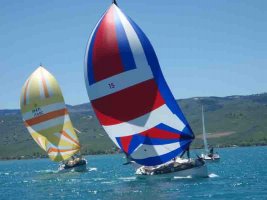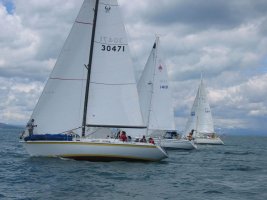Doug177
Member III
We took second in our cruising division on a cross Lake Michigan race of 66 miles in our E-35-3 yesterday. We had a J-35 asym reacher up on a two foot bowsprit. We were doing 7 + knots. Beat all the J-35's in division 2 on corrected time, but a Jenneau Sun Odyssey 40 SD who took third in the whole fleet did us in. Overall, we were 9th in fleet and they were 3rd. A bunch of Farr 40's, 395's and Great Lakes 70's beat us.
We were almost upright the whole crossing, beam reach 15kt winds gust to 20kts flat seas gradually increasing to short steep stern quartering 3-5 ft seas toward the end with us maybe heeling 5 degrees. In the last couple of hours as the seas built, steering became a quite active affair.
Would it have helped our speed if we increased the waterline by heeling more? Would it have increased the waterline by heeling more? Even a 10th of a knot over 66 miles would have make a big difference. Plus, it was our first race in the boat with a young crew who was just learning asym trim.
Doug
We were almost upright the whole crossing, beam reach 15kt winds gust to 20kts flat seas gradually increasing to short steep stern quartering 3-5 ft seas toward the end with us maybe heeling 5 degrees. In the last couple of hours as the seas built, steering became a quite active affair.
Would it have helped our speed if we increased the waterline by heeling more? Would it have increased the waterline by heeling more? Even a 10th of a knot over 66 miles would have make a big difference. Plus, it was our first race in the boat with a young crew who was just learning asym trim.
Doug


